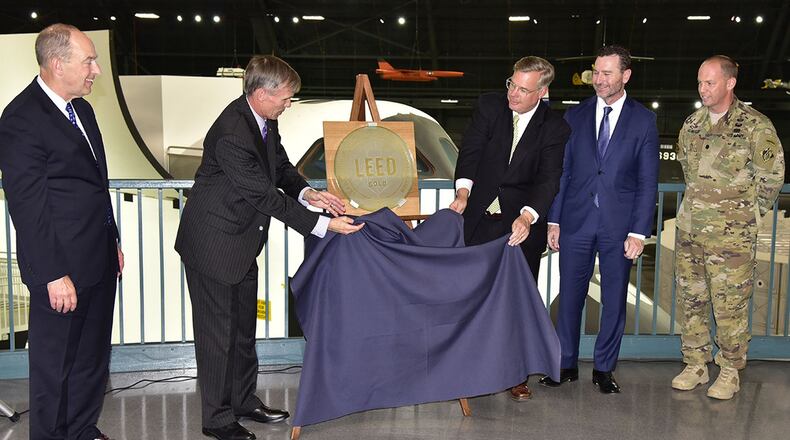The $40.8 million, 224,000-square-foot building, which was privately financed by the Air Force Museum Foundation, houses four galleries – Presidential, Research and Development, Space and Global Reach, along with three STEM (science, technology, engineering and mathematics) learning nodes.
Kyle Rooney, senior vice president, Turner Construction Co., said original plans for the addition called for it to be certified as LEED Silver, but Museum Director Jack Hudson challenged the project team to make product, system and design choices that would lead to such energy savings as to earn a LEED Gold certification.
Brian Curtin, president/CEO and chairman of the board, BRPH Architects-Engineers Inc., said improving the lighting and air conditioning systems was a major part of the 39 percent in energy savings from new mechanical and electrical systems.
“This is a very energy-efficient building,” Curtin said. “This is a great showplace for the National Museum of the U.S. Air Force.”
Lt. Col. Robert Newbauer, deputy commander, U.S. Army Corps of Engineers, Louisville District, said the project was another example of the strong and positive relationship his organization has with the 88th Air Base Wing, 88th Civil Engineer Squadron and Wright-Patterson Air Force Base.
“What an accomplishment by all the members of the project delivery team,” Newbauer said. “What truly sets this project apart from others is that this particular addition was privately financed by the Air Force Museum Foundation and is the first non-appropriated funds project that the Louisville district has participated in and achieved a LEED Gold rating.”
Philip Soucy, chairman, Board of Trustees, Air Force Museum Foundation Inc., said more than 1 million people have visited the museum since the addition opened.
“Not only are we honoring every Airman’s story, but we are also inspiring future generations through the museum’s educational STEM programs, and the fourth building allows us to take that one step further than what already existed here previously,” Soucy said.
“The museum is filled with stories of Airmen who have gone the extra mile to serve our country, so it is only fitting that we go the extra mile to achieve LEED Gold certification in the fourth building,” Hudson said. “These environmentally friendly measures not only serve the museum well by keeping our utility bills down but also allow us to do our part in taking care of our planet and preserving its natural resources.”
Notable statistics regarding the fourth building’s energy and environmental design include:
• 91 percent of building materials were locally sourced;
• 75 percent of non-hazardous waste was recycled;
• 45 percent of building materials came from recycled content;
• 36 percent decrease in water usage.
The LEED Gold plaque will displayed prominently in the fourth building, Hudson said.
“We want to make sure people understand we have the LEED Gold rating for the new building,” he added. “This building was produced in an environmentally responsible way. The long-term sustainment cost of the building is as low as we get it, due to the LED lights and the additional insulation we bought.
“Getting to LEED Gold was the right thing to do for long-term support considerations,” Hudson said.
James Levy, 88th Civil Engineer Group’s design manager for the fourth building and now a program manager, said many of the choices made for the fourth building’s design will minimize future maintenance the group will have to perform.
“There are a lot of benefits to the LEED Gold certification,” he said.
About the Author
